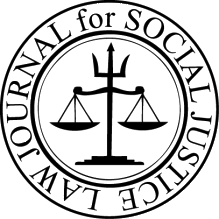Editor’s Note:
Now in its fourteenth year, the Law Journal for Social Justice continues to pursue its mission to promote diverse voices and advance important conversations around timely social justice issues. The articles within this volume were thoughtfully curated to provide academic analysis on a variety of social justice topics as well as calls to action for students and practitioners in the legal community. With a broad focus on environmental, educational, and criminal justice, the articles in this volume bring attention to the pervasiveness of injustice in our society, offer new perspectives, and present thoughtful solutions to difficult issues.
Volume Eighteen begins with A Tale of Two Committees: Comparing Police Officer Standard and Training (POST) Bodies by Nino Monea. In the article, Monea pulls back the curtain on how Police Officer Standard and Training Post Bodies operate in the context of decertifying officers for wrongdoing. In analyzing the POSTs of Oregon and Kansas, Monea highlights a troubling lack of accountability and transparency in the current police oversight system. Monea concludes by offering policy suggestions to improve public safety and policing outcomes. While POSTs have a valuable role to play in keeping misbehaving police officers accountable, there is still work to be done.
Next, Cayley Balser, Erin Weaver, Stacy Rupprecht Jane, Gabriela Elizondo-Craig, Tate Richardson, and Antonio Coronado at Innovation for Justice present their research and propose regulatory reform suggestions to improve access to justice for marginalized communities in Leveraging Unauthorized Practice of Law Reform to Advance Access to Justice. The authors emphasize the need for diverse voices to be included in the design and implementation of regulatory reform efforts and advocate for improving access to legal training within community-based organizations.
In Prison Siting from an Environmental Justice Perspective: The Toxic Cycle of Mass Incarceration, Jacqueline Cochrane shifts the conversation to environmentally hazardous prisons—an emerging issue where environmental justice and criminal justice intersect. Cochrane argues for increased accountability for state and federal actors in toxic prison siting. Additionally, Cochrane proposes an Eighth Amendment claim for the environmental harms that people who are incarcerated are forced to endure.
In Answering the Question of Intent in Structural Racism: A Tortious Framework for Establishing Intentional Discrimination in Environmental Justice, Mai Rubin proposes a new legal framework for environmental justice claims involving discriminatory siting. Rubin suggests tort law holds the answer for improved legal outcomes for marginalized communities where the Equal Protection Clause of the Fourteenth Amendment has fallen short.
Lastly, Esteban Ortiz argues for meaningful educational opportunities for all in K-12 schools in Educational Equality, Educational Adequacy: A Conjunction for the Future. He urges that proper education must include both an adequate and equal education experience for all students. In doing so, it will be possible to achieve equity in K-12 education.
LJSJ would like to thank the authors of this volume for their dedication to social justice and willingness to share their knowledge. I would also like to extend my deepest gratitude to the members of the LJSJ Board and Associate Editors whose efforts this past semester made this publication possible.
Megan Ealick | Editor-in-Chief, 2023-2024
